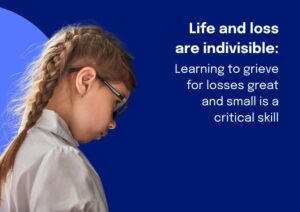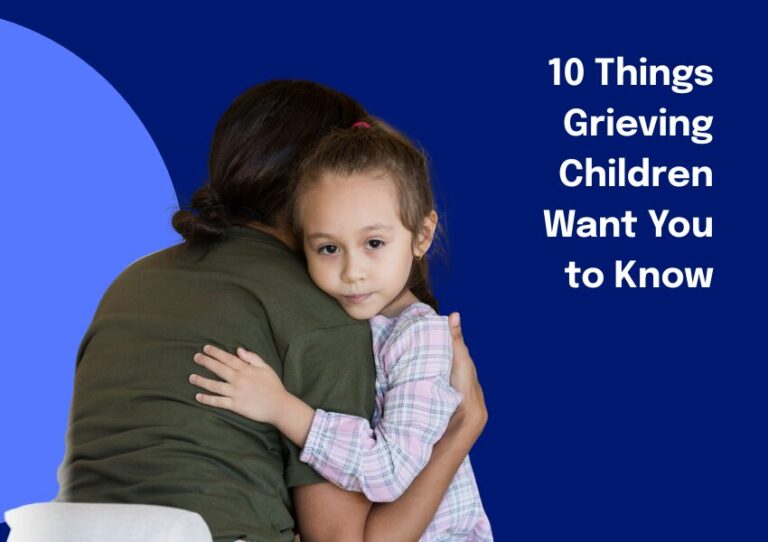Life and loss are indivisible: Learning to grieve for losses great and small is a critical skill
 Children, like all of us, continually experience loss. As much as they may celebrate their increased capacity to ‘do stuff’ like riding a bicycle or attending school, they also feel the loss of the special attention and privileges they had when they were younger and more dependent.
Children, like all of us, continually experience loss. As much as they may celebrate their increased capacity to ‘do stuff’ like riding a bicycle or attending school, they also feel the loss of the special attention and privileges they had when they were younger and more dependent.
They feel loss when their family moves, when people in the family leave home, when pets die, when the boy or girl they like doesn’t like them, or when their best friend finds a new No. 1. They feel loss when holiday traditions change or vacations are suspended due to financial strain on the family. They feel loss when Grandpa can’t pick them up and twirl them around anymore, and when Grandpa dies.
Learning to grieve for losses great and small is a critical skill in a child’s healthy development.
Children who do not learn to grieve are unequipped for life, as life and loss are indivisible.
Without the ability to grieve, children will grow up feeling confused, overwhelmed and helpless in the face of losses. They may become totally stuck, weighed down physically and emotionally, chronically irritable or even explosive with anger. They might become dependent on anything that allows them to avoid dealing with the losses, such as dependence on nonstop technology or being busy all the time. They may try to avoid loss by avoiding attachment and love. They might also turn to the anesthetizing effects of alcohol, drugs, or food to numb out from the simmering feelings within them.
The critical skill of grieving, like any skill, must be taught. Children do not magically learn to grieve on their own.
As parents, one powerful and effective way to teach the skill of grieving to your children is to model it for them. When you skillfully face your own losses and practice the skill of grieving, your children learn through your example. If you were never taught how to grieve, you can make a commitment to learn or improve your own skills at grieving; the better you become at grieving, the more effective you can be in showing your child how to grieve.
When you, as a parent or caregiver, model grief for your children, you attune to your own feelings and recognize how certain feelings are triggered by loss. For example, you might notice that you feel sadness or melancholy after finding out that your child no longer wants a hug in the morning, or pain and emptiness when you realize that you and your brother may never have a healthy relationship. You might notice that you feel angry when your partner isn’t there for you in ways that feel supportive, or sick to your stomach when you see that today’s date is the day your mom passed away three years ago.
Following this attunement to yourself, you can move forward in the grief process by working hard to see the whole picture — that life is sadness and loss as well as happiness and connection. You can search within yourself to find whatever it is that keeps you going in the face of pain and loss, whether it is your love for your family, your love of the natural world, your spiritual beliefs, a pragmatic ‘life is for the living’ attitude, some combination of these, or anything that fits for you.
As you allow yourself to acknowledge your pain and move through the grief process, you can narrate your experience for your children in an age-appropriate way:
‘You can probably see that I am feeling sadness. I am remembering my mom. It makes me feel sad and angry and lonely. I like to take a moment and just close my eyes and let go, like I am on a roller coaster, and let the feelings wash through me. Sometimes I scream a little in my head — ‘aaaaaa.’ It hurts inside.
‘Then I think about the love I have for you and the amazing joy of the first spring rain, and then I open my eyes and I go back to today. I am really looking forward to going to the park later.’
As you model this grieving process, your children see that delving into loss is not dangerous or destructive, but simply a part of living. They will see and sense how you experience the pain and then come out and participate in daily life. They will see and sense the wholeness of you, their parent, as you hold the pain and love, darkness and light, together inside of you as one package, being careful to not let the pain nullify the love, or the darkness blacken the light. They see that it is possible to hold on and to let go — and even to do them both at the same time.
When children learn to navigate the terrain of loss, through your modeling, they become familiar with the cycles of grief and do not cower in fear when losses occur. They become practiced in the art of moving into the pain and emotions and then moving back out into the light of day. They gain perspective and find that yes, life is painful, but that yes, life is also joyous. They find their own resilience, and the light within them that keeps them going amid pain and disappointment. With each grief cycle, they become ever more resilient and capable of creating a life that is meaningful to them.
More Articles By Danielle Grossman

